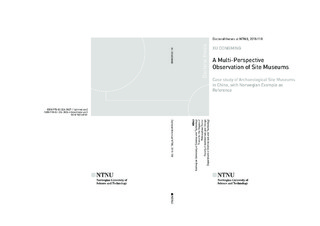| dc.description.abstract | Based on the documentation and analysis of anthropological fieldwork carried out from 2009 to 2015 on three selected site museum cases, this dissertation focuses on the phenomenon of installation management in Chinese site museums placed in the context of high-paced social transformation and modernization, with a Norwegian example as reference. It begins with a brief history of the formation of Chinese and Norwegian conservation institutions. Thereafter, it proposes and tests a social communication pattern of site museum management in China, explored via the origin and definition of ‘site museum,’ by revisiting some related essential conservation principles. Finally, it provides an assessment framework composed of the authenticity, integrity, and continuity concepts which build upon the fundamental issues of site museums.
The Daming Palace National Heritage Park and Han Yangling Museum in Xi’an, specifically the archaeological exhibition hall for the Outer Burial Pits of Yangling Imperial Cemetery of Han Dynasty, are taken as the study cases in China for the field investigation and further exploration. Meanwhile, the Hedmark Museum, an archaeological site museum in Norway, acts as the reference example for the fieldwork and research. Methodologically, this involves a multi-perspective approach which combines historical, anthropological, archaeological, and architectural studies on site museums. The methods of social anthropology are employed as the scientific tools in the fieldwork through semi-structured interviews and participant observation. Particularly, the interview documentation concentrates on the reflection of the different participants including museum staff, archaeologists, architects, civil engineers, contractors, and conservation officers who represent different institutions participating in the related site museum projects. A critical analysis of the cases helps clarify the basic principles of site museum construction and may also be useful for similar practices in other countries. Together, the collected interview notes provide valuable insights into the role of archaeological site museums in the operation of cultural heritage management and enhancement. Sixteen informants from different professional fields were interviewed. These interviews provide valuable documentation as oral history records that can draw an overall picture of the Chinese and Norwegian cases. Particularly, many of the interviewees, as professionals in different relevant fields of museums and architectural conservation, express their different thoughts and ideas on the practice of architectural conservation in China and Norway, meriting this study as a baseline for future research. | nb_NO |
